This week’s column includes some recently published books that explore the magic of words and inspire creative wordplay. Other books celebrate the joy that comes from listening to and reading books as well as the importance of libraries and bookshops in our lives.
Ages 4–8
A Busy Creature's Day Eating!: An Alphabetical Smorgasbord. Mo Willems. 2018. Hyperion.
 In Mo Willems’ outrageously funny picture book, a purple creature eats various edible (apples, berries, cereal) and nonedible (jacket, kilt, lunch box) items in alphabetical order. By the letter P, the creature feels ill and turns green from all the eating. The rest of the letters of the alphabet are depicted as remedies to soothe the creature’s tummy troubles. This clever spin on the traditional alphabet book, with Willems’ colorful cartoon illustrations and iconic frame-by-frame format, takes young readers on a humorous eating escapade—and comes with a warning: “Do not try this at home!”
In Mo Willems’ outrageously funny picture book, a purple creature eats various edible (apples, berries, cereal) and nonedible (jacket, kilt, lunch box) items in alphabetical order. By the letter P, the creature feels ill and turns green from all the eating. The rest of the letters of the alphabet are depicted as remedies to soothe the creature’s tummy troubles. This clever spin on the traditional alphabet book, with Willems’ colorful cartoon illustrations and iconic frame-by-frame format, takes young readers on a humorous eating escapade—and comes with a warning: “Do not try this at home!”
—LC
The Great Dictionary Caper. Judy Sierra. Ill. Eric Comstock. 2018. Paula Wiseman/Simon & Schuster.
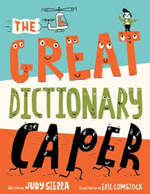 This playful story introduces readers to Noah Webster, writer of the first dictionary of American English. A linguistic adventure unfolds when Webster’s words decide to take a break and escape across the story pages. The anthropomorphized letters and words are grouped together to teach various language concepts—from the onomatopoeia marching band to mirrored anagrams and hide-and-seek antonyms. The digitally rendered cartoon illustrations make the words in this book come alive. Leap is shown leaping across the page, little is drawn as a tiny insect, and big fills the whole page. An appended glossary provides definitions for language-related terms used in the book.
This playful story introduces readers to Noah Webster, writer of the first dictionary of American English. A linguistic adventure unfolds when Webster’s words decide to take a break and escape across the story pages. The anthropomorphized letters and words are grouped together to teach various language concepts—from the onomatopoeia marching band to mirrored anagrams and hide-and-seek antonyms. The digitally rendered cartoon illustrations make the words in this book come alive. Leap is shown leaping across the page, little is drawn as a tiny insect, and big fills the whole page. An appended glossary provides definitions for language-related terms used in the book.
—LC
An Inconvenient Alphabet: Ben Franklin & Noah Webster’s Spelling Revolution. Beth Anderson. Ill. Elizbeth Baddeley. 2018. Paula Wiseman/Simon & Schuster.
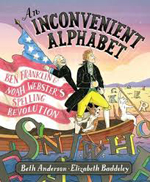 Ben Franklin thought people should spell words by writing the sounds they hear. He created a new alphabet, eliminating letters that didn’t match sounds and adding some new ones so that each letter had its own. Noah Webster thought people should say the sounds that were written and wrote Blue-Backed Speller to teach American English focusing on pronunciation. Franklin and Webster’s meeting in 1786 launched a spelling revolution that eventually led to Webster’s 1806 publication of his American Dictionary of the English Language, which included many of his spelling changes and thousands of new words. Readers will enjoy spotting the cat and dog that join Franklin and Webster in promoting the usage of a standardized American English in the humorous illustrations.
Ben Franklin thought people should spell words by writing the sounds they hear. He created a new alphabet, eliminating letters that didn’t match sounds and adding some new ones so that each letter had its own. Noah Webster thought people should say the sounds that were written and wrote Blue-Backed Speller to teach American English focusing on pronunciation. Franklin and Webster’s meeting in 1786 launched a spelling revolution that eventually led to Webster’s 1806 publication of his American Dictionary of the English Language, which included many of his spelling changes and thousands of new words. Readers will enjoy spotting the cat and dog that join Franklin and Webster in promoting the usage of a standardized American English in the humorous illustrations.
—CA
Sylvia’s Bookshop: The Story of Paris’s Beloved Bookstore and Its Founder (As Told by the Bookstore Itself!). Robert Burleigh. Ill. Katy Wu. 2018. Paula Wiseman/Simon & Schuster.
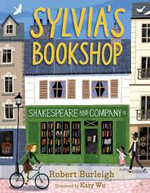 A bookshop narrates the history of Shakespeare and Company and the passionate book lover who made it into a "magical" gathering place for writers and thinkers. Katy Wu’s colorful, digitally rendered illustrations complement Robert Burleigh’s rhyming text to celebrate this special bookshop. Back matter includes a “Hurrah for Books and Bookstores!” note, information on Sylvia Beach (1897–1962) and Shakespeare and Company, and brief biographical sketches on writers and artists (mentioned only by their first names in the story)—Ernest Hemingway, Gertrude Stein, Janet Flanner, F. Scott Fitzgerald, James Joyce, Simone de Beauvoir, and Man Ray—who gathered at Shakespeare and Company.
A bookshop narrates the history of Shakespeare and Company and the passionate book lover who made it into a "magical" gathering place for writers and thinkers. Katy Wu’s colorful, digitally rendered illustrations complement Robert Burleigh’s rhyming text to celebrate this special bookshop. Back matter includes a “Hurrah for Books and Bookstores!” note, information on Sylvia Beach (1897–1962) and Shakespeare and Company, and brief biographical sketches on writers and artists (mentioned only by their first names in the story)—Ernest Hemingway, Gertrude Stein, Janet Flanner, F. Scott Fitzgerald, James Joyce, Simone de Beauvoir, and Man Ray—who gathered at Shakespeare and Company.
—CA
The Wall in the Middle of the Book. Jon Agee. 2018. Dial/Penguin.
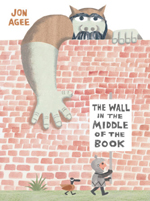 Jon Agee erects a brick wall in this book’s gutter as a clever way to separate one side of the book from the other. A small knight is happy to be safe on his side of the wall, away from the wild animals and the ogre who live on the other side. When the knight’s side begins to fill with water, he begins to realize his side might not be so terrific. Luckily, the ogre reaches over the wall and plucks the knight to his side, which turns out to be a good thing for him (as readers will know from seeing the fish in the water on the side that he’s just been rescued from being devoured by larger and larger fish with each turn of a page). Agee’s playful use of the gutter takes a functional aspect of a book’s structure and turns it into a focal point for the story being told.
Jon Agee erects a brick wall in this book’s gutter as a clever way to separate one side of the book from the other. A small knight is happy to be safe on his side of the wall, away from the wild animals and the ogre who live on the other side. When the knight’s side begins to fill with water, he begins to realize his side might not be so terrific. Luckily, the ogre reaches over the wall and plucks the knight to his side, which turns out to be a good thing for him (as readers will know from seeing the fish in the water on the side that he’s just been rescued from being devoured by larger and larger fish with each turn of a page). Agee’s playful use of the gutter takes a functional aspect of a book’s structure and turns it into a focal point for the story being told.
—LC
Ages 9–11
Bookjoy, Wordjoy. Pat Mora. Ill. Raul Colón. 2018. Lee & Low.
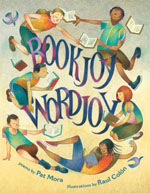 Pat Mora’s introduction to Bookjoy, Wordjoy ends with an enthusiastic invitation: “Let’s read, let’s write, let’s explore galore!” Her collection of 14 poems, paired with Raul Colón’s expressive illustrations, rendered in watercolor and colored pencil, explore the fun of collecting words and using them in our speaking and writing and the pleasure of listening to, reading, and sharing books. An appended “Note to Educators and Families” includes a reminder that learning should be a mix of work and play, and that too often the reading and writing experiences of children involve “the work and not the play, the wordjoy”
Pat Mora’s introduction to Bookjoy, Wordjoy ends with an enthusiastic invitation: “Let’s read, let’s write, let’s explore galore!” Her collection of 14 poems, paired with Raul Colón’s expressive illustrations, rendered in watercolor and colored pencil, explore the fun of collecting words and using them in our speaking and writing and the pleasure of listening to, reading, and sharing books. An appended “Note to Educators and Families” includes a reminder that learning should be a mix of work and play, and that too often the reading and writing experiences of children involve “the work and not the play, the wordjoy”
—CA
The Bookshop Girl. Sylvia Bishop. Ill. Poly Bernatene. 2018. Peachtree.
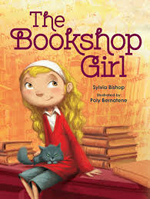 Eleven-year-old Property Jones, whose unique name comes from being left in the lost property cupboard at the bookstore when she was a young child, loves living in the White Hart bookshop. Netty Jones and her son Michael, the shop owners who adopted Property, remain unaware of her secret. Property doesn’t know how to read. When the Jones’ win a contest to become the new owners of the Great Montgomery Book Emporium, they close their used bookstore and arrive at the Emporium. They are delighted by the expansive bookshop and its rotating rooms, each dedicated to a different genre, but are quickly left to their own devices when the previous owner, Albert H. Montgomery, hastily departs. The Jones family soon discovers the reason for Montgomery’s swift disappearance and with the help of Property’s keen observational skills, solve the mystery that threatens to destroy their fantastic British bookshop.
Eleven-year-old Property Jones, whose unique name comes from being left in the lost property cupboard at the bookstore when she was a young child, loves living in the White Hart bookshop. Netty Jones and her son Michael, the shop owners who adopted Property, remain unaware of her secret. Property doesn’t know how to read. When the Jones’ win a contest to become the new owners of the Great Montgomery Book Emporium, they close their used bookstore and arrive at the Emporium. They are delighted by the expansive bookshop and its rotating rooms, each dedicated to a different genre, but are quickly left to their own devices when the previous owner, Albert H. Montgomery, hastily departs. The Jones family soon discovers the reason for Montgomery’s swift disappearance and with the help of Property’s keen observational skills, solve the mystery that threatens to destroy their fantastic British bookshop.
—LC
Eat Your Words: A Fascinating Look at the Language of Food. Charlotte Foltz Jones. Ill. John O’Brien. 2018. Delacorte/Random House.
 Charlotte Foltz Jones serves ups a tasty treat of a book on the language of foods, “a shopping list of curious food etymology, and a menu of the origins of funny-sounding food.” Each of the eight chapters includes examples, John O’Brien’s clever black-and-white cartoons, fun facts, and a “Food for Thought” section. There are entries on foods named for people (such as Beef Stroganoff and Eggs Benedict), foods with place-related names (such as Baked Alaska and Buffalo Wings), a “Talking Turkey” chapter of common food-related sayings (such as “eat humble pie,” “spill the beans,” and “sell like hotcakes”), and more. Readers will find themselves savoring the entire book.
Charlotte Foltz Jones serves ups a tasty treat of a book on the language of foods, “a shopping list of curious food etymology, and a menu of the origins of funny-sounding food.” Each of the eight chapters includes examples, John O’Brien’s clever black-and-white cartoons, fun facts, and a “Food for Thought” section. There are entries on foods named for people (such as Beef Stroganoff and Eggs Benedict), foods with place-related names (such as Baked Alaska and Buffalo Wings), a “Talking Turkey” chapter of common food-related sayings (such as “eat humble pie,” “spill the beans,” and “sell like hotcakes”), and more. Readers will find themselves savoring the entire book.
—CA
Thomas Paine and the Dangerous Word. Sarah Jane Marsh. Ill. Edwin Fotheringham. 2018. Hyperion.
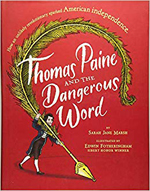 This engaging picture book biography of Thomas Paine (1737–1809) includes an abundance of words, phrases, and sentences from British-born wordsmith Paine’s writings that are hand-lettered and incorporated into Edwin Fotheringham’s digital artwork. After immigrating to the American colonies in 1774, Paine, a persuasive debater and writer, became a powerful voice for independence with his pamphlet Common Sense. Back matter includes author Sarah Marsh’s notes on Thomas Paine’s The American Crisis, the first of 13 essays urging support of the war; publication of Paine’s political views throughout his life; and the legacy of his continued influence and inspiration of America’s leaders, as well as a timeline, bibliography, and source notes for quotations.
This engaging picture book biography of Thomas Paine (1737–1809) includes an abundance of words, phrases, and sentences from British-born wordsmith Paine’s writings that are hand-lettered and incorporated into Edwin Fotheringham’s digital artwork. After immigrating to the American colonies in 1774, Paine, a persuasive debater and writer, became a powerful voice for independence with his pamphlet Common Sense. Back matter includes author Sarah Marsh’s notes on Thomas Paine’s The American Crisis, the first of 13 essays urging support of the war; publication of Paine’s political views throughout his life; and the legacy of his continued influence and inspiration of America’s leaders, as well as a timeline, bibliography, and source notes for quotations.
—CA
Ages 12–14
The Lost Books: The Scroll of Kings. Sarah Prineas. 2018. HarperCollins.
 Escaping the military aspirations set forth for him by his father, 15-year-old Alex becomes an apprentice librarian. When the master librarian he is serving mysteriously dies, Alex assumes his role and becomes royal librarian at the castle of Queen Kenneret. Alex soon learns of the deaths of several other librarians in neighboring kingdoms, and his suspicions surrounding his own master’s death are confirmed. Someone, or something, is killing royal librarians. When he discovers that certain books are alive and may be responsible for the librarians’ deaths, Alex sets outs to solve the mystery of the Lost Books that are hidden deep within the royal libraries. This fast-paced fantasy novel leaves readers wondering where Alex’s adventures might take him next.
Escaping the military aspirations set forth for him by his father, 15-year-old Alex becomes an apprentice librarian. When the master librarian he is serving mysteriously dies, Alex assumes his role and becomes royal librarian at the castle of Queen Kenneret. Alex soon learns of the deaths of several other librarians in neighboring kingdoms, and his suspicions surrounding his own master’s death are confirmed. Someone, or something, is killing royal librarians. When he discovers that certain books are alive and may be responsible for the librarians’ deaths, Alex sets outs to solve the mystery of the Lost Books that are hidden deep within the royal libraries. This fast-paced fantasy novel leaves readers wondering where Alex’s adventures might take him next.
—LC
What a Wonderful Word: A Collection of Untranslatable Words from Around the World. Nicola Edwards. Ill. Luisa Uribe. 2018. Kane/Miller.
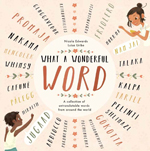 Diving into this collection of 30 words from around the world that have no one-word translations is the perfect way for word lovers to expand their collections of words. Each entry in this beautifully formatted book includes a block of text, including a word, its language of origin, a “translation” into English, it usage, and some facts about the culture, paired with a colorful painting. For example, koyaanisqatsi (Hopi) is translated as “Nature that is out of balance or a way of life that is so crazy it cannot continue long-term,” and on a humorous note, pålegg (Norwegian) is translated as “Anything and everything you can put on a slice of bread.” A pronunciation guide is appended.
Diving into this collection of 30 words from around the world that have no one-word translations is the perfect way for word lovers to expand their collections of words. Each entry in this beautifully formatted book includes a block of text, including a word, its language of origin, a “translation” into English, it usage, and some facts about the culture, paired with a colorful painting. For example, koyaanisqatsi (Hopi) is translated as “Nature that is out of balance or a way of life that is so crazy it cannot continue long-term,” and on a humorous note, pålegg (Norwegian) is translated as “Anything and everything you can put on a slice of bread.” A pronunciation guide is appended.
—CA
Ages 15+
Dictionary Stories: Short Fictions and Other Findings. Jez Burrows. 2018. HarperCollins.
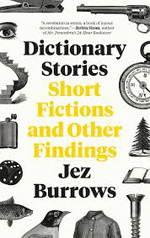 Jez Burrow’s has created an intriguing way of playing with words while exploring a dictionary. Dictionary Stories includes 150 short “stories” composed entirely of example sentences from 12 dictionaries, including the New Oxford American Dictionary, Merriam-Webster’s Collegiate Dictionary, and Collins Primary Learner’s Dictionary. Burrow’s introduction includes “The Rules” for making small edits to the example sentences in the dictionary stories that are written in a variety of forms (fantasies, eulogies, lists, math problems, and more) and arranged alphabetically by topic. For example, under Education, “Sample Problems: Intermediate Mathematics for Poets” includes mind-boggling word problems such as, “What do you get if you multiply 6 by 9 with gay abandon?”
Jez Burrow’s has created an intriguing way of playing with words while exploring a dictionary. Dictionary Stories includes 150 short “stories” composed entirely of example sentences from 12 dictionaries, including the New Oxford American Dictionary, Merriam-Webster’s Collegiate Dictionary, and Collins Primary Learner’s Dictionary. Burrow’s introduction includes “The Rules” for making small edits to the example sentences in the dictionary stories that are written in a variety of forms (fantasies, eulogies, lists, math problems, and more) and arranged alphabetically by topic. For example, under Education, “Sample Problems: Intermediate Mathematics for Poets” includes mind-boggling word problems such as, “What do you get if you multiply 6 by 9 with gay abandon?”
—CA
Laura Cutler is a PhD student in the Department of Human Development and Family Sciences at the University of Delaware. Carolyn Angus is former director of the George G. Stone Center for Children's Books, Claremont Graduate University, in Claremont, California.
These reviews are submitted by members of the International Literacy Association's Children's Literature and Reading Special Interest Group (CL/R SIG) and are published weekly on Literacy Daily.